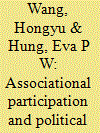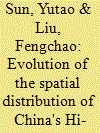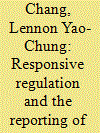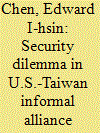|
|
|
Sort Order |
|
|
|
Items / Page
|
|
|
|
|
|
|
| Srl | Item |
| 1 |
ID:
114084


|
|
|
|
|
| Publication |
2012.
|
| Summary/Abstract |
Spatial distribution is an important dimension of research into the development of high technology (hi-tech) industries due to the knowledgeintensive features of these industries. This paper separates the agglomeration effects and the spillover effects, and analyzes the evolution of the spatial distribution of China's hi-tech sub-industries from themid-1990s by combining the geographic concentration index (locational Gini coefficient, concentration ratio) and spatial econometrics (Moran's I). The results reveal that, firstly, most hi-tech subindustries tend to be concentrated in the eastern coastal regions of China, while there are significant spillover effects from the eastern coastal regions to the central regions. The development model based on national hi-tech industrial zones is the primary reason for industrial agglomeration, and it is the result of both government direction andmarket rules. Secondly, on the macro-level, there has been a certain amount of geographical concentration and interregional division of labor among China's hi-tech industries, but there is low intraregional specialization. Furthermore, in contrast to the findings of most of previous studies, the distribution ofChina's hi-tech industries and that of its innovation capacity share similar evolutionary trends, although they do not completely overlap.
|
|
|
|
|
|
|
|
|
|
|
|
|
|
|
|
| 2 |
ID:
114083


|
|
|
|
|
| Publication |
2012.
|
| Summary/Abstract |
Spatial distribution is an important dimension of research into the development of high technology (hi-tech) industries due to the knowledgeintensive features of these industries. This paper separates the agglomeration effects and the spillover effects, and analyzes the evolution of the spatial distribution of China's hi-tech sub-industries from themid-1990s by combining the geographic concentration index (locational Gini coefficient, concentration ratio) and spatial econometrics (Moran's I). The results reveal that, firstly, most hi-tech subindustries tend to be concentrated in the eastern coastal regions of China, while there are significant spillover effects from the eastern coastal regions to the central regions. The development model based on national hi-tech industrial zones is the primary reason for industrial agglomeration, and it is the result of both government direction andmarket rules. Secondly, on the macro-level, there has been a certain amount of geographical concentration and interregional division of labor among China's hi-tech industries, but there is low intraregional specialization. Furthermore, in contrast to the findings of most of previous studies, the distribution ofChina's hi-tech industries and that of its innovation capacity share similar evolutionary trends, although they do not completely overlap.
|
|
|
|
|
|
|
|
|
|
|
|
|
|
|
|
| 3 |
ID:
114082


|
|
|
|
|
| Publication |
2012.
|
| Summary/Abstract |
This article investigates how corporate social responsibility (CSR) is operated inChinawith a particular focus on the role of the government. It finds that CSR in China is implemented through two big networks: one for foreign invested enterprises, mostly consisting of voluntary initiatives targeting Chinese domestic consumers, and the other of domestic stateowned enterprises (SOEs), implementing non-voluntary, governmentdriven initiatives mostly targeting foreign markets. The role of the government is especially critical in the latter network. The government has developed a national strategy to encourage SOEs to promote CSR by issuing guidelines, providing various kinds of support for research and conventions, and developing China's own reporting standards in certain industries. Government intervention has resulted in the creation of two separate worlds of CSR and a Chinese version of government-led CSR in which the role of civil actors such as nongovernmental organizations is seriously limited.
|
|
|
|
|
|
|
|
|
|
|
|
|
|
|
|
| 4 |
ID:
114080


|
|
|
|
|
| Publication |
2012.
|
| Summary/Abstract |
As most software used by government agencies and companies is proprietary, malicious computer activity targeting breaches in that software can be likened to a pandemic of an infectious disease in the cyber world. When a breach occurs, the consequences can be widespread and damaging because the damage can spread rapidly. Therefore, cybercrime prevention needs to involve all users in a cooperative effort,with warnings and information on countermeasures distributed to users in order to prevent the "disease" from spreading when unprotected computers encounter an attack. This cooperative effort relies heavily on all institutions reporting information security incidents. Based on institutional theory, together with regulatory pluralism and responsive regulation theory, this paper examines the pluralized regulatory approach adopted to promote a system for sharing reports of information security incidents in Taiwan and China. An expanded model of regulatory enforcement and a strengths-based pyramid are proposed and used as a framework for discussing existing systems for encouraging the reporting of information security incidents.
|
|
|
|
|
|
|
|
|
|
|
|
|
|
|
|
| 5 |
ID:
114078


|
|
|
|
|
| Publication |
2012.
|
| Summary/Abstract |
This article has two main goals, one is to explore whether the improvement in cross-Strait relations has increased both the risk of entrapment for Washington and the fear of abandonment for Taipei since 2008, and the other is to examine why the United States provides Taiwan with strategic reassurance. The two main international relations (IR) theories applied in this article are Charles Lipson's theory of informal alliance and Glenn H. Snyder's theory of security dilemma in alliance politics. Taipei may be hoping that when cross-Strait negotiations move from economic and cultural issues to politically sensitive ones, Washington will play the role of guarantor or supervisor. However, the United States may believe that playing such a role would increase its risk of entrapment. On the other hand, fear of abandonment for Taiwan is more likely to arise when the cross-Strait relationship further deepens and expands. While most observers believe that Taiwan's fear of abandonment is greater than Washington's risk of entrapment, some are of the opinion that the rise of China will eventually allow Beijing to intimidate Taipei, leading to Taipei's submission, if cross-Strait relations get out of control. Fortunately, bearing China's expansionist behavior in 2010 in mind, the United States is taking steps to focus its attention on Asia once again, and also emphasizing that Taiwan is an important security and economic partner, thereby easing Taipei's fear of abandonment. Thus, the main conclusion of this article is that while a relatively swift improvement in cross-Strait relations may increase the risk of entrapment forWashington and the fear of abandonment for Taipei, it seems that both the United States and Taiwan have reached a consensus that their current informal alliance should be nurtured by means of strategic reassurance, given China's potentially expansionist behavior.
|
|
|
|
|
|
|
|
|
|
|
|
|
|
|
|
| 6 |
ID:
114079


|
|
|
|
|
| Publication |
2012.
|
| Summary/Abstract |
Since the beginning of the twenty-first century, Taiwan has faced both a deterioration in its trade position and a strong sense of isolation from the rapidly growing Asian regionalism due to numerous unsuccessful attempts to ink free trade agreements (FTAs) with major trading partners. Among these attempts, the effort to reach a U.S.-Taiwan FTA during the presidencies of George W. Bush and Chen Shui-bian warrants serious treatment. With reference to the two main approaches to analyzing FTAs in the current scholarship, this paper elaborates the trade and strategic approaches and makes a comparison between them. It is found that the substantial steps Taiwan took in 2004 and 2005 to resolve its trade disputes with the United States did not open the door to formal talks on an FTA before the U.S. fast-track legislation expired in 2007. On the contrary, the divergence in strategic interests between the two sides explains theU.S. decision to set aside Taiwan's request for an FTA in 2003 and to openly reject another such request in 2006. In other words, the strategic perspective provides amore satisfactory explanation than the trade perspective for the evolution of the U.S.-Taiwan FTA issue.
|
|
|
|
|
|
|
|
|
|
|
|
|
|
|
|
|
|
|
|
|